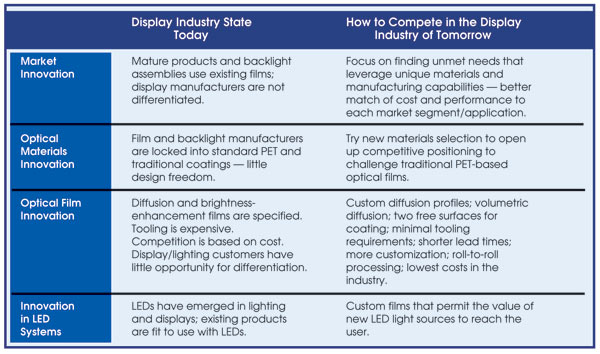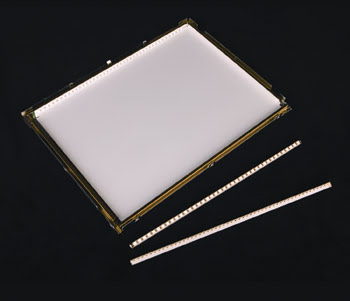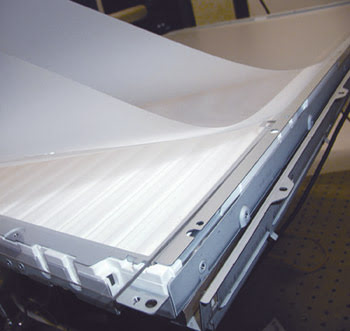LCD backlight units reap the benefits of advances in materials and manufacturing.
Dr. Terence E. Yeo, Fusion Optix Inc.
Global displays are poised to overtake semiconductors and become a $100 billion industry. Flat panel displays, and in particular liquid crystal displays (LCDs), are ubiquitous and are found in products ranging from cell phones to big-screen TVs. It seems as if the display industry is introducing something new every few months: Whether an enhancement of a current product, such as brighter desktop monitors, or something radically different, such as Apple’s rotating screen for the iPhone, new consumer products are around every corner.
Behind the scenes, component suppliers and system assemblers are fighting for ground amid rapid commoditization. Among the fierce competition in what is still a rapidly growing industry, LCD panel manufacturers and makers of the backlight units that drive them are looking to material suppliers and component manufacturers for improved performance and significant cost reductions to improve margins.

Table 1. Innovation across the display industry supply chain is vital to sustain performance and price reduction requirements.
Integral components such as light-management films in their various forms and efficient cold-cathode fluorescent lighting tubes are now widely available. Perhaps most significant is the recent rise in capabilities and resources in display panels and backlights from China and, before that, from Taiwan and South Korea. In a short space of time, manufacturing powerhouses have emerged to challenge an industry built from headquarters based in North America, Western Europe and Japan. In the area of materials and components, a market once dominated by one or two large players is now undergoing a form of deregulation as Asia-based capacity ramps up and price wars ensue.
According to market research firm DisplayBank of Gyeonggi-do, South Korea, the leading optical film market segment in displays of the past few years has been prism films for LCDs. Another significant development is the rapid rise in the use of LEDs in backlighting. In March, DisplayBank reported that the market share for LED backlight units for large-area displays, such as those used in TVs, would grow from virtually zero to more than 10 percent by 2010.

Figure 1. LEDs are finding increasing application in LCDs.
In June 2006, brightness-enhancement and dual-brightness-enhancement films accounted for more than half of the cost of a 32-in. LCD backlight unit, according to DisplaySearch. This is too high to maintain market share in an environment where pricing is the ultimate key to success. Because of strong patent protection in this area, there is little hope that many new companies will surface, in the short term at least, leaving more and more companies with only one option: to reduce cost by changing system designs to enable cheaper films.
The battlefield is therefore now firmly at the backlight systems’ level, with many combinations of diffusion, prism and microlens films being tested. All of these trends suggest that the 2010 display market will look very different from the one we see today. To profit from those changes, companies must innovate.
Fusion Optix’s contribution to the display industry is based on a series of patents received in the 1990s. Researchers at the Cambridge, Mass.-based company have found that the key to unique diffusion films lies in the manufacturing rather than in the coating process, which takes place after a roll of film has been manufactured. By manipulating the materials on a molecular level, physical characteristics, such as thickness and surface roughness, and optical characteristics, such as haze, diffusion profile and gloss, can be controlled during manufacture. By incorporating the diffusion properties into the bulk of the film, further benefits are delivered, including improved handling, resulting in better yields in high-volume LCD panel assembly processes.

Figure 2. Optical films are integral in large-area LCD TVs.
The company is looking into the next stage for these films. By adding precision prism and microlens structures to the surface of diffusion films, multifunctional films have been born. They deliver collimation and diffusion in a single film, the benefits of which are fewer optical films and higher overall efficiencies in the display. Other companies have experimented with multifunctional films, but few are ready for market.
Because of the base technology, multifunctional films are relatively easy to manufacture; the challenge is breaking open an optical film market that is well-established and in the midst of a price war.
Meet the author
Terence E. Yeo, president and CEO of Fusion Optix Inc. of Cambridge, Mass.; e-mail: terry.yeo@fusionoptix.com.